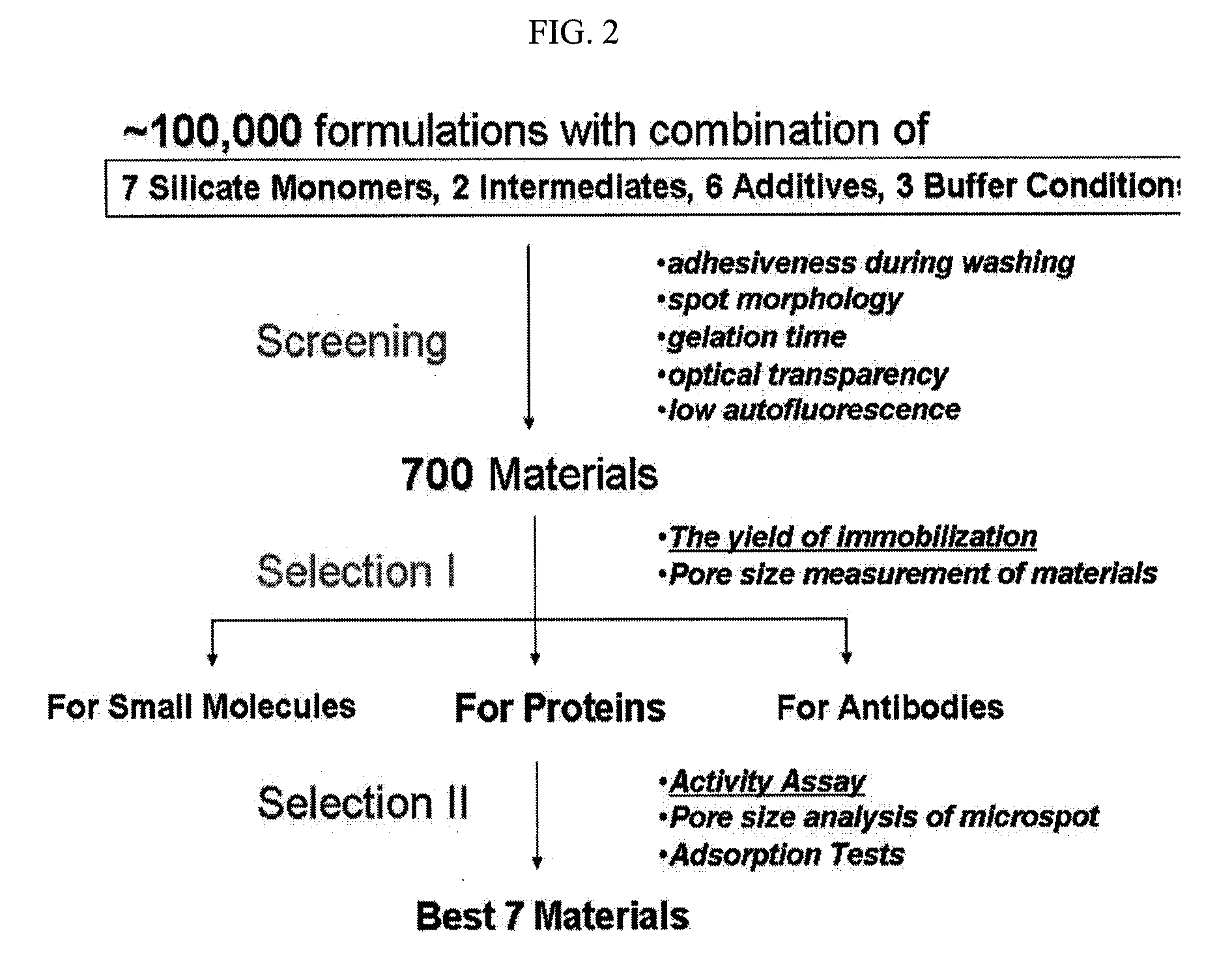Sol composition for sol-gel biochip to immobilize probe on substrate without surface treatment and method for screening thereof
a biochip and solgel technology, applied in the field of screening a sol composition for solgel biochips, can solve the problems of difficult work, variable problems, and difficult to achieve success, and achieve the effect of improving the screening efficiency and screening efficiency
- Summary
- Abstract
- Description
- Claims
- Application Information
AI Technical Summary
Benefits of technology
Problems solved by technology
Method used
Image
Examples
example 1
Screening of Sol Compositions which are Specific for a Substrate and Biomaterials and, at the Same Time, can be Immobilized Directly on the Substrate
[0080]A sol-gel composition, which can withstand strong washing even when it is immobilized directly on a surface-untreated substrate, and, at the same time, has excellent physical properties when it is fabricated into a biochip, was rapidly screened by the inventive screening method (FIG. 2). FIG. 2 is a flow diagram showing a method for screening a sol composition which forms spots on a surface-untreated substrate, and FIG. 3 shows examples of compositions selected and excluded in the screening method of FIG. 2. It can be seen that the excluded compositions could not immobilize biomaterials such as proteins without surface treatment and were completely detached during a washing process.
[0081]First, about 100,000 sol compositions based on silicate monomers were spotted on a substrate and measured with respect to strong adhesion capable...
example 2
Enzyme Immunological Diagnosis of Disease through Immobilization of Sol-Gel Protein Chip Spots Immobilized on 96-Well Plate
[0096]In this Example, the sol compositions selected in Example 1 were measured using an automated ELISA diagnosis process which is currently used for hepatitis diagnosis. The automated diagnosis process comprised an intense washing process, and thus among the screened compositions, a composition was used in which the spots showed strong adhesion and could maintain the characteristic circular shape thereof even after washing. The sol composition used in this Example was optimized such that the formed spots could withstand even physical scratching using Abbott Axsym and a Roche Elecsys device.
[0097]In this Example, when the material of a 96-well plate for the composition selected through this process was plasma-treated PMMA, a mixture of the sol composition for immobilization and a protein solution consisted of 17.5-25 parts by weight of TMOS, 5-15 parts by weigh...
example 3
Fabrication and Analysis of Biochip using Gold Chip Substrate
[0104]In this Example, a sol composition for immobilization on a gold chip substrate was selected according to the same method as in Example 1 using a gold (Au) chip used in a SPRi system. In the case of the gold chip, adhesives (1010 and 1020; LG Chemical Co., Ltd., Korea) as additives were added to the sol composition for immobilization. The sol mixture after spotting was modified into a substance, which was transparent like glass and had pores, but the sol mixture was not immobilized on the gold chip, the surface of which was coated with Au. In this Example, in order to immobilize sol spots on the gold chip surface, additives were used, and the composition of the used sol mixture was composed of 16.2-18.7 parts by weight of TMOS, 3.7-6.2 parts by weight of MTMS, 13.7-16.2 parts by weight of GPTMOS, 0.01-20 parts by weight of adhesives (1010, 1020, etc.), 12.5 parts by weight of 10 mM HCl, 23.7-24.5 parts by weight of di...
PUM
 Login to View More
Login to View More Abstract
Description
Claims
Application Information
 Login to View More
Login to View More - R&D
- Intellectual Property
- Life Sciences
- Materials
- Tech Scout
- Unparalleled Data Quality
- Higher Quality Content
- 60% Fewer Hallucinations
Browse by: Latest US Patents, China's latest patents, Technical Efficacy Thesaurus, Application Domain, Technology Topic, Popular Technical Reports.
© 2025 PatSnap. All rights reserved.Legal|Privacy policy|Modern Slavery Act Transparency Statement|Sitemap|About US| Contact US: help@patsnap.com



